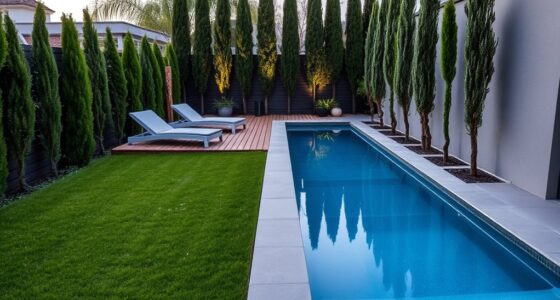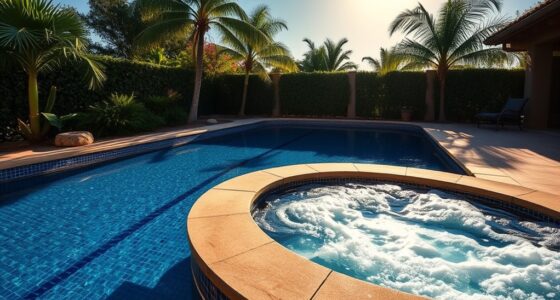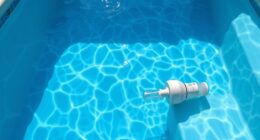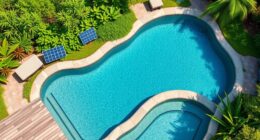Converting your existing pool into a lap pool can be feasible if it has enough length—ideally 40 to 75 feet—and a suitable shape. You’ll need to evaluate its current size, shape, and structural condition to determine if modifications like lengthening or widening are practical and affordable. Safety features, proper lighting, and slip-resistant surfaces are essential for usability. Keep exploring, and you’ll discover how expert advice can help you transform your pool into a perfect lap space.
Key Takeaways
- Assess your current pool’s size and shape to determine if it can be modified for lap swimming.
- Structural changes like lengthening or widening may be necessary, which can be costly depending on existing dimensions.
- Safety features such as non-slip surfaces, proper lighting, and appropriate depth are crucial in renovation plans.
- Consulting with professional pool specialists ensures feasible modifications and adherence to safety standards.
- Additional features like lane lines, heating, and covers can enhance functionality and transform your pool into a dedicated lap pool.
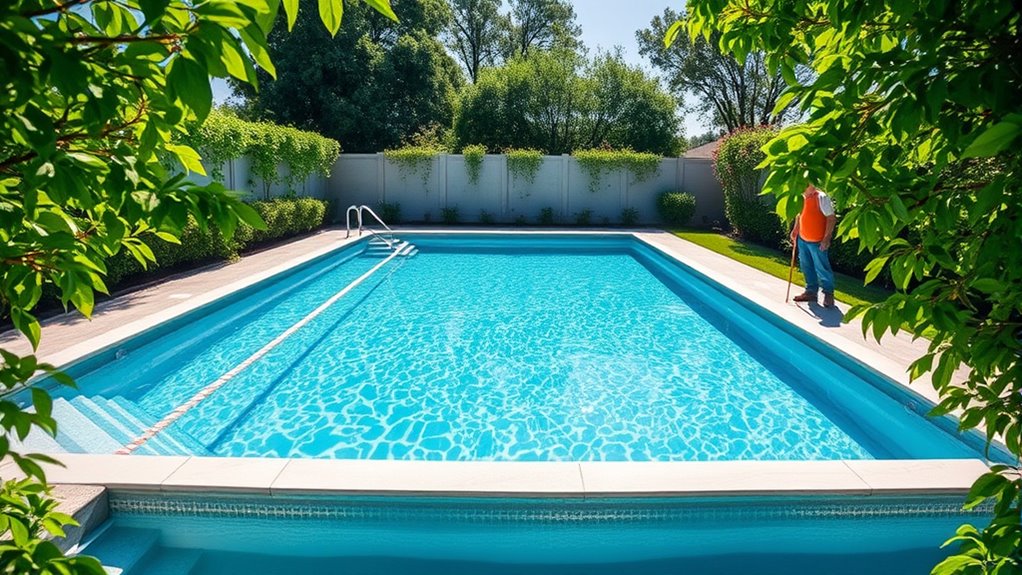
Are you considering transforming your current pool into a dedicated lap pool? If so, you’re likely weighing the benefits of a sleek, functional swimming space against the effort and cost involved. Converting your existing pool is a popular option, especially if you want a space optimized for fitness without building anew. However, before jumping into the project, it’s vital to understand what’s involved in such a transformation, especially regarding pool renovation and safety considerations.
First, assess your current pool’s size and shape. Lap pools typically require a minimum length of 40 to 75 feet to allow for effective swimming laps. If your existing pool is considerably smaller or irregularly shaped, it might not be feasible to convert it into a proper lap pool without extensive modifications. Sometimes, a simple renovation can suffice—adjusting the length, widening the pool, or installing a lane line system. But if your pool’s dimensions are far from ideal, you may need to consider more substantial structural changes, which could be costly and time-consuming.
When planning your pool renovation, safety considerations should be front and center. A lap pool’s design demands smooth, even surfaces around the deck to prevent slips and falls. You’ll want to guarantee the pool’s depth is appropriate—usually shallow enough for safe swimming but deep enough for comfortable laps. Proper lighting is essential, both for visibility and safety during night swims. Additionally, installing non-slip flooring and secure handrails can prevent accidents, especially if you have children or elderly swimmers around. Remember, a well-planned renovation doesn’t just enhance aesthetics; it improves safety and usability.
Consulting with professionals experienced in pool renovation is a wise step. They can evaluate your existing pool’s structure, suggest modifications, and ensure the renovation meets safety standards. They’ll also help you choose the right materials and fixtures tailored to your needs. Keep in mind that some features, like installing lane lines, a pool cover, or a heating system, can transform a regular pool into a functional lap pool efficiently. Moreover, considering color accuracy in lighting and finishing materials can enhance the visual appeal and safety of your new lap pool.
Frequently Asked Questions
How Long Does the Conversion Process Typically Take?
You’re probably wondering about the construction timeline for a pool renovation. Typically, converting your pool into a lap pool takes anywhere from 2 to 4 weeks, depending on the scope of work and existing pool size. Factors like permits, design changes, and contractor schedules can influence this timeline. To stay on track, communicate clearly with your contractor and plan for some potential delays, ensuring a smooth renovation process.
Will Converting Reduce My Current Pool’S Overall Size?
Imagine stepping into your pool, and wonder if it’ll feel smaller after the conversion. Typically, converting your pool into a lap pool doesn’t change its overall size; it’s more about reshaping or extending the length. However, you’ll need to take into account the pool’s depth and water chemistry to guarantee it functions perfectly. So, while the size stays the same, the design adjustments make it ideal for lap swimming.
Are There Specific Pool Shapes That Work Best for Conversion?
When considering pool shapes, rectangular designs typically work best for conversion into lap pools, as they maximize swimming length and minimize installation challenges. Round or irregular shapes often complicate the process, making installation more difficult and expensive. You should evaluate your current pool’s shape to see if it aligns with a practical, streamlined design that facilitates a smooth progression to a lap pool.
What Is the Estimated Cost of Converting to a Lap Pool?
They say, “You get what you pay for,” and that’s true for converting your pool to a lap pool. The cost considerations depend on your existing pool’s size and condition, with prices typically ranging from $5,000 to $15,000 or more. Budget planning is key, as renovations can add up. Keep in mind, investing wisely guarantees you enjoy a functional lap pool without overspending.
Can I Add Features Like a Heating System After Conversion?
You can definitely add features like pool heating after your conversion, but you’ll want to consider retrofit feasibility first. Installing pool heating systems is usually straightforward if your pool’s structure allows for it. You’ll need to assess space, existing plumbing, and electrical setup. Consulting a professional helps ensure proper installation, so you get efficient pool heating without compromising your new lap pool’s design or functionality.
Conclusion
Converting your existing pool into a lap pool is definitely feasible, especially if you have the space and budget. Keep in mind that a typical lap pool is around 40 feet long, so you’ll want to measure carefully. Did you know that homeowners who convert their pools often see a 20% increase in property value? This upgrade not only boosts your fitness routine but also enhances your yard’s appeal—making it a smart, stylish investment.


